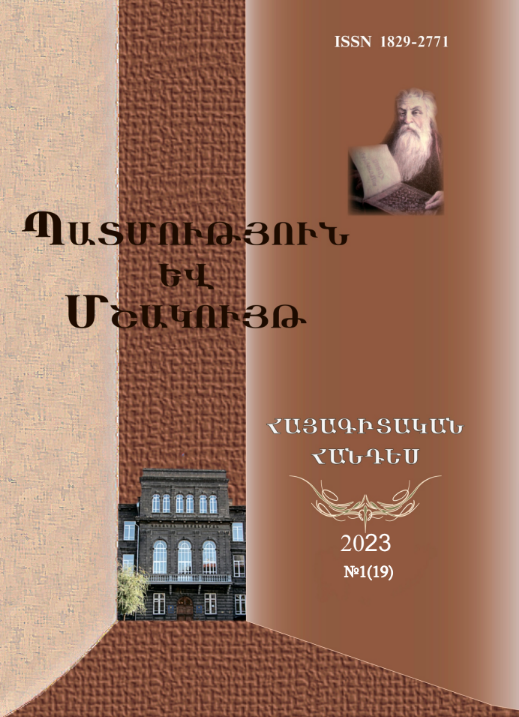The war of civilizations in the works of Armenian artists
DOI:
https://doi.org/10.46991/hc.2023.19.1.284Keywords:
Civilization, war, Armenian artists, civilized civilization, Battle of Avarair, Invention of writing, Genocide, SumgaitAbstract
Even in ancient civilizations, battle scenes were created in different branches of art: sculpture, relief, mural painting, etc. In ancient civilizations, they served not only as a model of art, but, perhaps, rather as a means of preaching. By depicting their leaders as the victors (who may have, actually, lost the war) of the state, the government aimed atupholding the spirit of the warrior, the victor. The art at all times has been a direct reflection of historical events, thereby creating a platform for researchers to uncover the events of the given period centuries and millennia later. Therefore, the history of art is first of all the history of humanity, the history of civilizations. In this article we will present the works in Armenian art of XIX-XXI centuries (paintings and graphics) concerning the war and civilizational situations and conditioned by them, making comparisons not only with Armenian but also with world art samples. The depictions of Armenian artists include the reflection of our heroic pages, as well as the painful pages of our history, starting with the depiction of widespread massacres and inconceivable atrocities that began in various regions of Western Armenia in the 1890s, until the events of Sumgait. The antiquity of all this does not at all heal the wounds, leading to oblivion, moreover, it is the basis of new creations for artists to prevent human and cultural genocide, civilizational wars.
References
Աղասյան Ա. 2015, Համիդյան ջարդերի և Մեծ Եղեռնի արտացոլումը հայ կերպարվեստում (1894-1923թթ.), Պատմաբանասիրական հանդես 2, Երևան, էջ 13-29:
Աղասյան Ա․ 2018, Հայ կերպարվեստի և կիրառական արվեստի կորուստներն Օսմանյան կայսրության մեջ (համիդյան ջարդերից մինչ մեր օրերը), Երևան։
Աղասյան Ա. 2019, Կոմիտասը հայ նկարիչների աչքերով, ՀՀ ԳԱԱ Գիտություն, Երևան, 49 էջ։
Բլան Ք․ 2002, Ժանսեմ, Երևան։
Գասպարյան Հ. 2007, Հայոց պատմության էջեր իտալացի նկարիչների գրաֆիկական աշխատանքներում, Տիգրան Մեծ, Երևան, 100 էջ:
Թերլեմեզյան Փ. 2009, Մի այցելություն հիվանդ Կոմիտասին, Կոմիտասը ժամանակակիցների հուշերում և վկայություններում, Սարգիս Խաչենց-Փրինթինֆո, Երևան, էջ 261:
Ժանսեմ, Հայաստանում արմատս գտա, Գարուն, N 4, 1978թ., էջ 68-77։
Խանջյան Գ. 2010, Մեր մեծերը, Արարատ հեռուստատեսություն։
Խաչատրյան Շ. 2010, Ցավի գույնը, Փրինթինֆո, Երևան:
Հայթայան Պ. 1985, Էդուարդ Իսաբեկյան, Սովետական գրող, Երևան։
Չուգասզյան Լ․ 1991, Հայկական ջարդերը, ազատամարտը և հայ արվեստագետները, Նորք, N 4, էջ 122-131։
Չուգասզյան Լ․ 1992, Մեծ Եղեռնը և հայոց հերոսամարտը հայ արվեստում, Ուրբաթ լրագիր, ապրիլի 24։
Չուգասզյան Լ․ 2011, Արշակ Ֆեթֆաճյան, Փրինթինֆո, Երևան, 188 էջ:
Քէօսէեան Գ. 1989, Գառզու, Մոգական աշխարհի մը նկարիչը, Հայկական բարեգործական ընդհանուր միության Ալեք Մանուկյան մշակութային հիմնադրամ, 496 էջ։
Arshile Gorky 1995, the breakthrough years, Modern Art Museum of Fort Worth.
Басовская Н. 2014, Война и мир в истории цивилизации (постановка проблемы на материале древней и средневековой истории), Вестник РГГУ․
Варданян Р. 2022, Живопись Валентина Подпомогова: трагический символизм, метафоричность и таинственность икон, Армянский музей Москвы и культуры наций, Москва.
Всеобщая история искусств, Искусство, Москва, 1956, (ред. А. Чегодаева), 920 с.
Степанян Н., Зурабов Б. 1987, Григор Ханджян, Живопись, Графика, Москва, Советский художник․
Downloads
Published
Issue
Section
License
Copyright (c) 2024 Hripsime Vardanyan

This work is licensed under a Creative Commons Attribution-NonCommercial-ShareAlike 4.0 International License.

